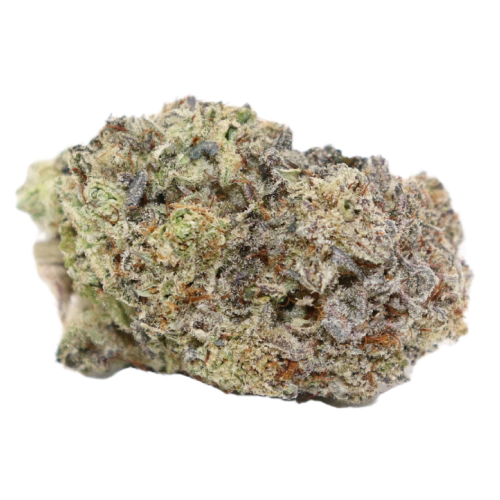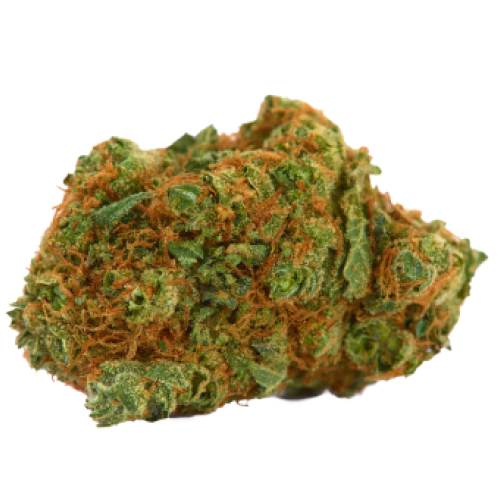
THC 18 - 21%
CBD 0.15 - 0.75%
Effect Calm
Flavor Earthy
16.08 - 18.17%
0.59 - 0.92%
0.1 - 0.55%
Sweet, Flowery
Tingly
The Huckleberry Cough strain is well-balanced cannabis with a 50/50 Indica/Sativa ratio, born from robust parents – Cough and Huckleberry Lemonade strains. It has an average level of THC concentration (ranging from 16.08% to 18.17%.)
Therefore, this strain is suitable for both beginners and experienced marijuana smokers with high sensitivity. The CBD level is close to 1%: from 0.59% to 0.92%. This weed is often used for therapeutic purposes due to the availability of the following cannabinoids. The following is a list of them:
Huckleberry Cough buds have a wide range of terpenes that affect the flavor and aroma. They are dominated by myrcene, sabinene, and limonene. Other terpenes found in Huckleberry Cough include:
Spicy and herbal Huckleberry Cough strain has a wide spectrum of characteristics in its fragrance and aftertaste. With the first inhale, you will feel thick, woody, and sweet smoke in your lungs. The line of mint, lemon, lime, and tea adds pleasant freshness to the tobacco aroma. Also, in the taste, you can feel the fruit salad of peaches, apples, grapes, and various berries, mangoes, and plums. It is accented with rose and lavender notes. Some smokers clearly feel the chemical taste of diesel or the bitterness of coffee with black pepper.
Consumers of Huckleberry Cough note the pleasant calm they feel for a long time after smoking. This strain effectively helps to get rid of the accumulated fatigue and stress and soothe the wandering mind. You will be able to concentrate on your activities or have a good time with friends and chat with some jokes. A smooth and deep feeling of happiness is revealed in a relaxed body until the tingling in the limbs. It gently relieves pain and tension and allows you to truly relax. Also, Huckleberry Cough cannabis is preferred by people in creative professions because it stimulates the imagination.
This strain of marijuana helps people cope with:
In most cases, Huckleberry Cough usage has only a healing positive effect. But hypersensitive users or those who have overdosed may experience side effects. They are usually not strong and do not overshadow the overall impression. You may feel tired or dizzy from low blood pressure, also among the negative effects of dry eyes and mouth.
The Huckleberry Cough bush grows tall and can give a good harvest inside and outside of the house. It is better to start growing it if you already have some experience in gardening. Indoors, the plant will grow up to 60-80 inches and give up to 400 grams of buds.
In the fresh air, it can grow up to 90 inches and give 550 grams of fresh crop. The flowering period will last approximately 56 to 74 days of plant life. And on the 80th day, the gardener can expect the first harvest.
| THC | Tetrahydrocannabinol, or THC, is a major cannabis chemical compound. It is a psychoactive element that stimulates dopamine release and induces euphoria or happiness. THC-rich strains may be helpful with such conditions as lack of appetite, chronic pains , etc. It is considered to be the primary active marijuana component. | 16.08 - 18.17% |
| CBD | Cannabidiol, or CBD, is a major compound in cannabis, which is non-psychoactive. It is also proved to counteract the side effects of the second major component THC. CBD is widely used for medicinal purposes in rubs, oils and so on. It is helpful in muscle pain cases, may treat arthritis and migraines. Even Greeks used it against pain, while Queen Victoria applied it to get rid of menstrual cramps. | 0.59 - 0.92% |
| CBC | Cannabichromene, or CBC, is a minor cannabinoid, meaning that its quantity in cannabis is quite little. Though it has the same origin as CBD and THC, it is different in functions. Without any psychoactive effects, it is an efficient cannabis compound in combating acne and depression. CBC produces analgesic, antibacterial and anti-inflammatory effects. | 0.19 - 0.38% |
| CBG | Cannabigerol, or CBG, is one of the minor cannabis compounds in adult plants. On the other hand, young ones contain a lot of this antibacterial and anti-inflammatory component. During the growth, CBG is converted into different cannabinoids, mostly THC and CBD. The compound itself increases appetite and decreases eye pressure. | 0.1 - 0.55% |
| CBN | Cannabinol, or CBN, is a trace element in cannabis that is considered to be mildly psychoactive. It appears from oxidation THC, exposed to light and heat. CBN is mostly contained in old cannabis and in traditional hashish. It is effective against insomnia, bacterial infections and appetite loss. | 0.23 - 0.18% |
| THCV | Tetrahydrocannabivarin, or THC-V, is a compound contained in cannabis in trace amounts. Even though it is close to THC molecularly, it is different in effects. This compound may be psychoactive only in large amounts. THC-V reduces blood sugar, controls appetite, stimulates bone growth, etc. African Sativa strains are the richest in THC-V. | 0.16 - 0.45% |
| Carene | Carene (also known as Delta-3 carene) is a terpene found in rosemary, lemons, pines, and cedars, offering citrusy and cypress aroma. Studies on mice showed that carene provides anti-inflammatory effects, as well as promotes bone health and chronic pain relief. | 0.05% |
| Pinene | Pinene is one of the most widespread terpenes in nature, found in pine trees, basil, nutmeg, parsley, and rosemary. Cannabis containing terpene (alpha-pinene or α-pinene) boasts a strong pine scent. Pinene is responsible for anti-inflammatory, pain-relieving, and anti-anxiety effects. | 0.2% |
| Myrcene | Myrcene (also known as β-myrcene) is one of the most common terpenes found in cannabis, representing more than 20% of the modern marijuana terpene profile. Myrcene has a distinct earthy, musky flavor, resembling cloves. It is responsible for calming and soothing effects of weed. Myrcene is also found in hops, thyme, mango, lemongrass, guava melon. | 0.22% |
| Ocimene | Ocimene (derived from the Ancient Greek word Ocimum meaning basil) is a terpene with sweet and herbaceous flavors, also boasting citrusy and woody undertones. Naturally, ocimene occurs in mint, parsley, orchids, hops, kumquats, mangoes, basil, bergamot, lavender, and pepper. Offers antifungal, anti-inflammatory, and antiviral properties. | 0.02% |
| Humulene | Humulene (also known as α-humulene) is one of the major terpenes found in cannabis, contributing to woody, earthy, spicy, herbaceous, and, mainly, floral aromas of cannabis. Used in modern medicine, humulene offers anti-inflammatory, antibacterial, and appetite suppressant effects, which have been well-researched by pharmaceutical companies. | 0.02% |
| Limonene | Limonene (also known as d-limonene) is the second most common terpene in nature and the third most common terpene in cannabis. It has a powerful citrus aroma and can be found in all citruses, including lemons, oranges, grapefruits, limes, juniper, etc. Limonene is known to elevate moods and provide anxiety, depression, and stress relief. | 0.13% |
| Linalool | Linalool (also known as beta linalool, linalyl alcohol, linaloyl oxide, and p-linalool) is one of the rarest terpenes found in cannabis, mostly in small quantities. Linalool is known for its spicy and lavender aroma, bringing relaxation and calming effects. It is also said to provide anti-inflammatory and analgesic properties that can be useful for athletes. | 0.03% |
| Sabinene | Sabinene is a terpene with a peppery, spicy, citrusy, and piney aroma, presented in Norway spruce, Holm oak trees, black pepper, cardamom, and carrot seeds. Found in cannabis in small quantities. Allegedly, sabinene has anti-inflammatory and antimicrobial properties. | 0.25% |
| Terpinolene | Terpinolene is one of the most common terpenes found in cannabis; however, It's usually presented in small quantities. Is responsible for piney, floral, herbaceous, and even a little bit citrusy aroma of cannabis. Terpinolene can be found in lilacs, nutmeg, and cumin. In cannabis, terpinolene contributes to the sensation of "freshness." Has the potential to reduce the risk of heart diseases. | 0.01% |
| Caryophyllene | Caryophyllene (also known as beta or b caryophyllene) is a terpene found in many herbs and spices, such as black pepper, basil, rosemary, and oregano. Cannabis high in caryophyllene delivers a strong spicy, peppery aroma, resembling cinnamon and cloves. Caryophyllene offers potent anti-inflammatory and sedative effects. | 0.06% |
| Total terpenes content | 0.99% |

THC 18 - 21%
CBD 0.15 - 0.75%
Effect Calm
Flavor Earthy
THC 16.5 - 19%
CBD 0.02 - 0.1%
Effect Talkative
Flavor Tropical
THC 24 - 24%
CBD 0.1 - 0.36%
Effect Calm
Flavor Lime
THC 18.4 - 22.4%
CBD 0.31 - 0.62%
Effect Sleepy
Flavor Earthy
THC 17.17 - 23%
CBD 3.53 - 3.66%
Effect Giggly
Flavor Flowery

THC 17.8 - 19.6%
CBD 0.37 - 0.73%
Effect Sleepy
Flavor Pine
THC 11.3 - 15.7%
CBD 0.02 - 0.19%
Effect Tingly
Flavor Apricot
THC 17.25 - 20.25%
CBD 0.33 - 0.57%
Effect Relaxed
Flavor Sweet
THC 18.75 - 20.75%
CBD 0.3 - 0.54%
Effect Tingly
Flavor Sweet
THC 19 - 24%
CBD 0.33 - 0.96%
Effect Uplifted
Flavor Plum
THC 16.67 - 21.67%
CBD 0.96 - 1.22%
Effect Happy
Flavor Lemon
THC 21 - 26%
CBD 0.38 - 2%
Effect Concentrated
Flavor Tar
THC 11.43 - 16.22%
CBD 0.02 - 0.29%
Effect Talkative
Flavor Citrus
THC 19.5 - 23%
CBD 0.4 - 0.53%
Effect Euphoric
Flavor Sweet
THC 14 - 18.33%
CBD 0.37 - 0.62%
Effect Happy
Flavor Citrus
THC 9.5 - 12%
CBD 0.02 - 0.16%
Effect Hungry
Flavor Grape
THC 19.12 - 20.52%
CBD 0.64 - 5.56%
Effect Relaxed
Flavor Sweet
THC 8 - 9.5%
CBD 0.05 - 0.93%
Effect Talkative
Flavor Plum
THC 25 - 28%
CBD 0.19 - 0.42%
Effect Sleepy
Flavor Pungent
THC 20.5 - 25%
CBD 0.26 - 0.46%
Effect Happy
Flavor Spicyherbal
Be the first and share your opinion
Write a Review